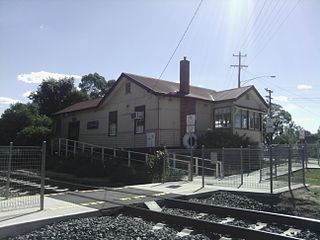
Broadmeadows railway station is a commuter, regional and inter-city railway station on the suburban Craigieburn line, the regional Seymour and Albury lines, and the inter-city Southern line. It serves the northern suburb of Broadmeadows in Melbourne, Victoria, Australia. Broadmeadows is a ground level premium station featuring three side platforms. Platforms 1 and 2 are used for broad gauge Metro and V/Line services, while Platform 3 is used for standard gauge V/Line and NSW TrainLink services. The station opened on 1 February 1873, with the current station provided in 1990.

St Kilda station is a current tram stop and former railway station, located in the Melbourne suburb of St Kilda, Australia, and was the terminus of the St Kilda railway line in the Melbourne suburban rail system. It is one of the oldest surviving railway station buildings in Victoria. The building is currently used as retail premises, while the platform serves as stop 132 on tram route 96.

Warrnambool railway station is a regional railway station and the terminus of the Warrnambool line, part of the Victorian railway network. It serves the city of Warrnambool, in Victoria, Australia. Warrnambool station is a ground level premium station, featuring one side platform. It opened on 4 February 1890.

Colac railway station is a regional railway station on the Warrnambool line, part of the Victorian railway network. It serves the town of Colac, in Victoria, Australia. Colac station is a ground level part-time staffed station, featuring one side platform. It opened on 27 July 1877.

Seymour railway station is on the Tocumwal and North East lines in Victoria, Australia. It serves the town of the same name, and opened on 20 November 1872. The station is the terminus for V/Line Seymour line services. V/Line services to Shepparton and Albury, and New South Wales XPT services to Sydney, also stop at the station.

Violet Town railway station is located on the North East line in Victoria, Australia. It serves the town of Violet Town, and it opened on 20 March 1873.

Benalla railway station is located on the North East line in Victoria, Australia. It serves the town of Benalla, and it opened on 18 August 1873.

Wangaratta railway station is located on the North East line in Victoria, Australia. It serves the town of the same name, and opened on 28 October 1873.

Sale railway station is a regional railway station on the Gippsland line, part of the Victorian railway network. It serves the town of the same name, in Victoria, Australia, and originally opened on 1 June 1877. The current station, on a different site, was opened in December 1983.

Albury railway station is a heritage-listed railway station at Railway Place, Albury, New South Wales, Australia, adjacent to the border with Victoria, in Australia. It was designed under the direction of John Whitton and built from 1880 to 1881. It was added to the New South Wales State Heritage Register in 1999.

The former Victorian Railways, the state railway authority in Victoria, Australia, built a number of experimental 2 ft 6 in narrow-gauge lines around the beginning of the 20th century. Although all were closed by the early 1960s, parts of two have been reopened as heritage railways.
Barnawartha is a closed station located in the town of Barnawartha, on the North East railway, in Victoria, Australia. The station building and platform lie between the Melbourne - Albury standard gauge line, opened in 1962, and the former broad gauge line, converted to standard gauge in 2010. There is a disused goods shed to the west of the tracks.

The Brisbane Valley railway line was a railway connection in Queensland, Australia connecting Ipswich, west of Brisbane, to the upper Brisbane River valley. Progressively opened between 1884 and 1913, the railway provided a vital transport link between Ipswich and Yarraman and forged development and prosperity along its path. The line acquired its serpentine reputation because it did not take a straight course when faced with a hill or gully.

The Crowes railway line was a 2 ft 6 in narrow gauge railway located in the Otway Ranges in south-western Victoria, Australia, running from the main line to Port Fairy at Colac to Beech Forest and later to Crowes.

Hamilton is a railway station located on the Ararat - Portland railway in the city of Hamilton, Victoria, Australia. Today the station is now used only for through trains, and the large station building is used only to serve bus passengers, although the disused platform remains in reasonable condition.

Zeehan railway station in Tasmania, was a major junction and railway yard for numerous different railway and tramway systems in western Tasmania in the town of Zeehan.

Whitfield Railway station was the terminus railway station for the Whitfield railway line. It was opened in 1899 and closed in 1953. It was the most distant narrow gauge railway station from Melbourne in Victoria.
Norman Houghton is a historian and archivist in Geelong, Victoria, who has published more than 40 books, many focusing on timber tramways and sawmills of the Otway and Wombat Forests of Western Victoria, Australia. Most of his works have been self-published, while he has provided numerous articles to the newsletter and journal of the Light Railway Research Society of Australia.

Warwick railway station is a heritage-listed railway station on the Southern railway line in Warwick, Southern Downs Region, Queensland, Australia. It was built from c. 1881 to 1910s. It was added to the Queensland Heritage Register on 24 September 1999.
Gellibrand was a railway station on the now-dismantled Victorian Railways narrow gauge Crowes railway line, 17 miles 20 chains (27.75 km) from Colac, Victoria. It had a single low-level platform with three tracks. A fourth one was added in 1923. The station closed in 1962, along with the Colac to Beech Forest section of the line.

















